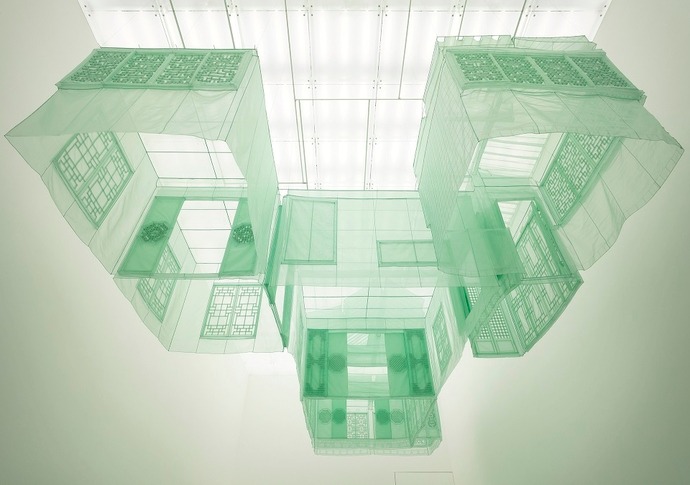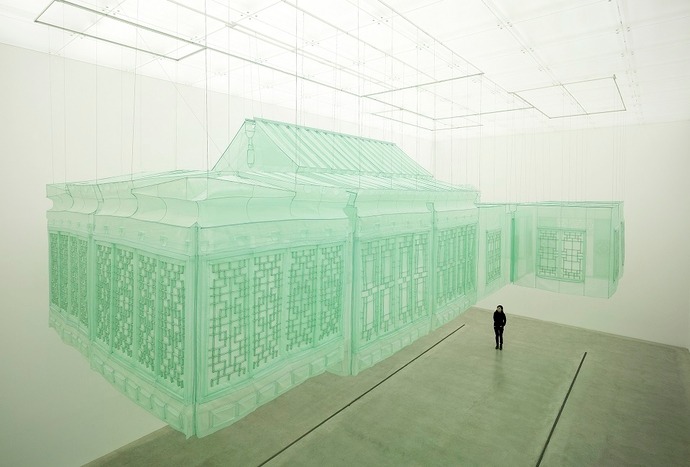
| Period| | 2019.04.30 - 2019.08.11 |
|---|---|
| Operating hours| | 10:00am - 07:00pm |
| Space| | Pohang Museum of Steel Art |
| Address| | 10, Hwanhogongwon-gil, Buk-gu, Pohang-si, Gyeongsangbuk-do, Republic of Korea |
| Closed| | Mon., Jan. 1st, Korean Holiday |
| Price| | Free |
| Phone| | 054-250-6000 |
| Web site| | 홈페이지 바로가기 |
| Artist| |
장영철,이정훈
|
정보수정요청



|
|
Exhibition Information




<Soft House, Beyond Steel> is an exhibition of installation art that captures Pohang's multilayered interest in the geographical environment after the 2017 earthquake disaster in Pohang. The meeting of the expressive medium of art and architecture will prove that art has always developed in the inevitable connection with modern technology, and that although social and political issues lead to the issue of art discourse, the intrinsic nature of art is not offset. This is the beginning of the war. The aftereffects of the earthquake disaster evoked interest in the materials of architecture, and saved that the damage of buildings built with heavy materials such as iron, glass and concrete could be a fatal hazard to the safety of urbanites. As a result, I was thinking about a shelter space in a city like Pavillion for people who lost their homes, and suddenly came to imagine a light "house" carrying around like a nomad. This led to the reason for the architectural 'space' formed with light and flexible building materials, and the concept of space of the new concept, which is almost anti-architecture and deconstruction in modern architecture, was drawn in the head. In modern art, 'space' is one of the main concepts that cannot be overlooked. This is even more so in installation art. In this exhibition, the aesthetic concept of space construction and dismantlement is to be reflected through architectural style installation techniques. As a "Museum of Steel Art," the Pohang Museum of Art has drawn interest in works of art using iron. Since its opening, the museum has been lighting on the use and aesthetic characteristics of iron in sculpture and installation areas, and in 2017 hosted the exhibition 《Steel Craft – Life Style》, which showcased the use and beauty of iron in everyday life. The art museum's aesthetic lighting of iron also applies to the field of architecture. The exhibition, however, sheds light on the architectural use of materials called iron and its aesthetic characteristics, as seen in the exhibition title "Beyond Steel," but rather on the movement of architecture to escape from steel. The move dreams of breaking away from the modern and contemporary architecture of iron, glass and reinforced concrete architecture. Exhibition is the visual and tactile embodiment of this dream. In other words, it experimentes with the potential for the construction of light and replaceable fluid materials beyond the boundaries of modern and contemporary architectural aesthetics that aim to build heavy and hard materials. The works on display demonstrate these signs of experimental architecture on various levels. The first is that the production process of the works is labor-intensive. In this era when the value of architecture is determined by capital, attempts to realize architectural formal beauty through labor-intensive actions rather than capital-intensive products run counter to the logic of capital supporting modern architecture. Labor-intensive behavior based on repeated body movements is against the order of capitalist architecture. The wartime is now said to be the body again. Repeated sewing at Seo Do-ho's "Seoul Home" and the cross act of Amsu Paper in "Waffle Valley" by Lee Jung-hoon require tremendous body labor. This implies the recovery of lost body sensation in the digital age and information age today. Second, all of the works on display regard the fundamental elements that determine architecture as a material. Seo Do-ho uses silver fabric, Jang Yeong-cheol uses mesh fabric, wood and steel (partial use), and Lee Jung-hoon uses honeycomb paper. As you may be aware, they all used light, interchangeable materials. Third, it embodies the concept of a mobile and flexible space. Seo Do-ho actually displayed his house-sized piece "Seoul Home" in Seoul, New York, Kanazawa and Beijing. The title of the work tells the history of the movement of the work. Jang Yeong-cheol, who reminds us of the essential elements of residence, uses mobile tent houses to metaphorize the spiritual life of a nomadic modern person, and the true freedom and happiness of life lies in emptiness. And built from the primordial material (paper) that adapts to nature, Lee Jung-hoon's is the culmination of his dream of building alternative building materials. Paper is a fragile material that can be easily damaged and wet, but a Fabillion-type "waffle Valley" made of honeycomb paper can withstand loads easily even if several people lie down. The construction power of woven paper materials and the embodiment of formal beauty make the viewer feel elastic. If the exhibition is approached in the historical context of architecture, it could be placed on the line of dislocation or demolitionism, but it is not an archive-style exhibition that sheds light on the history of architecture, but rather an exhibition that sheds light on the construction of light building materials and their aesthetic possibilities. Seo Do-ho, the installation artist who participated in the exhibition, Jang Young-chul, the director of the Wise Building Office, and Lee Jung-hoon, the director of the Cho Ho Building Office, will boldly attempt such an architectural experiment. Let's hope these experiments will serve as a forum for discussions on alternative architectural aesthetics, which can give hope to future generations.
